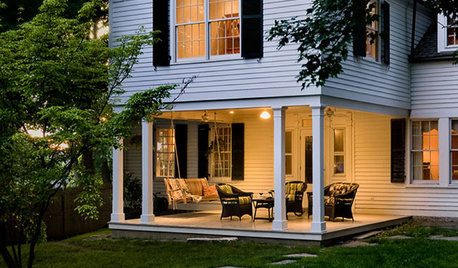large lawn renovation and grass recomendation.
panthers65
8 years ago
Featured Answer
Sort by:Oldest
Comments (25)
panthers65
8 years agoRelated Discussions
Lawn renovation - length of dead grass
Comments (6)I plan on keeping the existing KBG, I'm just over seeding with KBG flavors: midnight, bedazzled, and prosperity to take over the nasty KBG sod that came with house, its from the local sod farm. I do however have one large spot approx 500 sq feet that I recently shot with Round Up to kill off a POA problem that came with the sod Farm Turf. That part of the lawn is mostly dirt now and some rather ugly looking dead sod which looks like your picture. I plan on cuttung the the rest of my yard down to 1.5-2 inches and then over seed with a slit machine from Home Depot. Does this sound good to you?...See MoreRenovating poor lawn
Comments (4)If you are going to rent an aerator, you may as well aerate and seed the whole thing at once. Seed is fairly cheap. The sooner you get a decent strand of grass growing, the easier everything else becomes. As for topsoil, if you have low spots to fill, go for it. If you are just looking to improve the soil, you are better of topdressing with compost. That isn't something you have to do all at once though and you only need to apply 1/4" to get a big benefit. Are you looking for a showcase lawn or just a nice lawn for the kids to play in? If you are going for "the nicest lawn on the block" just roundup everything first. If you want "nice" you can leave the existing grass. Either way, you want to wait until the temps are 80 or so. Mow the existing lawn short and rake up the clippings. Rent an aerator and make several passes in crossing directions. Fill in any low spots with topsoil. Spread seed and fertilizer. If you want to topdress with compost, do that next. Then you just have to keep it watered - 2 or 3 times a day is best - until it comes up....See MoreRenovation Day 35 - More weeds than Grass in large areas!
Comments (16)No worries. I have a ton of weeds to. I have some areas that are more weed than grass. When you aerate or slitseed it brings the deeper soil to the surface which contains dormant weed seeds. Because you have no grass the stuff starts to germinate. I think the winter will kill most of the stuff off. Like others have said put down 2 good pre-emergents and maybe touch of milorganite down in the spring. One for Crab Grass and the other for broadleaf weeds. The milorganite should provide some slow release nutrients for any stress. It appears Weeds are a natural and expected part of the rennovation process so no worries. Just keep watering that KBG :)...See MoreNeed help with Lawn renovation in Northern Virginia
Comments (154)Hvae you done the shampoo thing? If you are concerned that the dirt is too hard, the surfactants in the shampoo will allow better water absorption. Have you had a soil test? By the way, I doubt anyone is reading this thread because it takes too darn long to scroll to the bottom to see what was said. And no way are they are going to read through the whole saga. I get an email alert that you said something (because I had commented) and I can click to the bottom. But anyone new to the thread would have to scroll down a long time. You might start another thread for future questions and concerns. And then someone other than me might have ideas for you....See MoreUser
8 years agopanthers65
8 years agoUser
8 years agoUser
8 years agodchall_san_antonio
8 years agopanthers65
8 years agolast modified: 8 years agoUser
8 years agodchall_san_antonio
8 years agobeckyinrichmond
8 years agopanthers65
8 years agoUser
8 years agopanthers65
8 years agopanthers65
8 years agoUser
8 years agopanthers65
8 years agoUser
8 years agopanthers65
8 years agopanthers65
8 years agoUser
8 years agopanthers65
8 years ago
Related Stories

GARDENING GUIDESSmall Gem Lawns: More Impact From Less Grass
Instead of letting the lawn sprawl, make it a shapely design element in your yard. You’ll reap benefits both practical and aesthetic
Full Story
GARDENING AND LANDSCAPINGRenovation Detail: The Ribbon Driveway
Grass paired with concrete for the driveway is more than just pleasing to the eye — it's good for the environment and your home
Full Story
LANDSCAPE DESIGNCalifornia Says Goodbye to the Sprawling Ornamental Lawn
New state rules will effectively limit turfgrass to 25 percent of the landscape in most new and renovated yards
Full Story
LAWN ALTERNATIVESStop Fighting the Patchy Lawn!
Here are 3 situations where a garden may be a better idea than more turfgrass
Full Story
GARDENING GUIDESHow to Prep Your Ground for a Healthy New Lawn
Seed or sod that falls on weedy, lumpy soil is a wasted effort. Follow these steps to ensure that your new lawn will thrive
Full Story
SAVING WATERHouzz Call: Are You Letting Go of Your Lawn?
Many facing a drought are swapping turf for less thirsty plantings. If you’re one of them, we’d like to hear about it
Full Story
GREAT HOME PROJECTSHow to Replace Your Lawn With a Garden
New project for a new year: Lose the turfgrass for energy savings, wildlife friendliness and lower maintenance
Full Story
LANDSCAPE DESIGNGet Along With Less Lawn — Ideas to Save Water and Effort
Ditch the mower and lower your water bill while creating a feast for the eyes with diverse plantings and gathering places
Full Story
FRONT YARD IDEASBefore and After: Front Lawn to Prairie Garden
How they did it: Homeowners create a plan, stick to it and keep the neighbors (and wildlife) in mind
Full Story
SELLING YOUR HOUSEThe Latest Info on Renovating Your Home to Sell
Pro advice about where to put your remodeling dollars for success in selling your home
Full Story









User